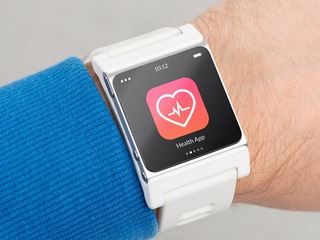The FDA outlines draft guidance on AI for medical devices
The agency also published draft guidance on the use of AI in drug development
Read more...
Editor's note: Our Splash Health, Wellness and Wearables event is coming up on March 23 in San Francisco. We'll have Steve Jurvetson (Draper Fisher Jurvetson), J. Craig Venter (Human Longevity), Patrick Chung (XFund), Risa Stack (GE Ventures), Paul Willard (Subtraction Capital), Julie Papanek (Canaan Partners) and more. Check out the full lineup and register for tickets before they jump! If you’re a healthcare startup and you’re interested in being part of our competition, learn more and register here.
For couples that are looking to have a child, there aren't many accurate ways to know the right time to try to get pregnant. There's the temperature method, where women take their temperature every day to see if it's going up, and hope to see a small change, and there are urine sticks, where women have to pee on them multiple times a day to get a result. The former isn't very accurate and the latter isn't very convenient.
That's where Ava, a medical technology company focused on innovations in women's reproductive health, comes in. It's a fertility tracking wearable that uses technology to detect the fertile window in a woman's cycle in real time.
The company, which launched just two and a half years ago, has now raised $9.7 million in a strategic Series A round, it was announced on Tuesday.
The round was led by European VC firm Polytech Ecosystem Ventures. Others contributing to the round include new investors Blue Ocean Ventures and Global Sources, along with company's existing seed investors Swisscom and ZKB and others from the healthcare and technology fields.
The company had previously raised a $2.6 million seed round in November of last year, bringing its total funding to $12.3 million.
Ava was started in 2014, when one of the wife of one of the co-founders of the company was trying to get pregnant, but found that she hated all of the methods currently available to track her cycle.
"We were in a lucky position a few years ago to have team that previously worked in healthcare, and in medical technology, and so we assumed we might be able to do something better," company co-founder Lea von Bidder told me in an interview.
"We knew that temperature reacts to hormonal changes, but, as temperature changes, maybe something else is changing as well. We just didn't know what," she said. So the founders did research, and read hundreds of papers to "explore what impact hormones have on the body besides temperature."
When there was no conclusive data, the company started its own clinical studies a year and a half ago, which ended in April, and which showed that Ava could more precisley track a woman's menstrual cycle based on more than just temperature.
"The biggest difference is that we can measure nine parameters, which allows us to get more precise, and allows us ro track not one hormone but two," von Bidder told me.
Unlike other similar services, which are only able measure temperature, Ava works by recording eight other physiological factors that correspond with the rise in hormones indicating the onset of ovulation: resting pulse rate, heart rate variability, sleep, breathing rate, movement, perfusion, bioimpedance and heat loss.
That allows Ava to be much more accurate than other methods.
With the temperature method, on the other hand, a woman might not know she is in the correct time of her cycle until only a few hours before that window closes. With urine sticks, while more accurate, they still will still only tell her a day or two before. Ava will be able to accurately tell her nearly a week before.
The FDA-approved Class One medical device, which costs $199, officially launched its first product to market this July. It was proven in a recently concluded clinical study at the University Hospital of Zurich to detect an average of 5.3 fertile days per cycle with 89 percent accuracy.
"We are taking cycle tracking to the 21st century," von Bidder said.
Right now there are already a few thousand women using Ava, and they range from younger couples looking to have their first child, to older couples who may not have as much time left to expand their family. A big customer base for Ava are families trying to have a second or third child, as infertility issues are more prevalent during those pregnancies.
A growing number of women, though, are using Ava even if they aren't looking to have a child, and that represents the future of the company.
"It was not surprising to me, but we really didn't market it as that. We are opening that up now, and, for me, it's really nice to see how much interest women have in their bodies. Their understanding of that is critical," said von Bidder.
Part of the new funding will go toward product development, and the company has a lot of idea of where to take it, including catering to that new subset of used.
"What we can do with the technology is fascinating. We can relate body perameter to hormonal changes and that's a really big thing," said von Bidder. "We started with fertility. That's where we came from but we see this that technology is applicable in so many areas. Ava can be a constant product for women in all different life stages. Those trying to get pregnant, and those trying not to get pregnant, and women going through menopause, allowing them to take action, whatever that may be."
One of the big areas that she would like to take Ava is contraception, allowing women to use the device to know when they can safely have sex without risk of pregnancy.
"For a lot of women, the temperature method is not accurate or reliable, so its not an option. So, our end goal for the product is to do that for them. To do it so accurately and so precisely that they would be limited to so few days as to make it both reliable and useful."
Currently, the algorithm is not trained for that type of use case, and it will take continued investing in research to get there, but von Bidder's hope it to have Ava be able to be used as birth control withing the next five years.
In addition, Ava will also use the funding to expand into international markets, launching in various European countries early next year including the United Kingdon, Switzerland, Austria and Germany.
Ava is a Swiss-based company, so going to Switzerland, Austria and Germany makes sense since the company has a lot of connections there, including its investors, and it has already started its second clinical study in Switzerland. As for the U.K., it's a big market and the country speaks the same language as the U.S.
"Our ultimate vision any woman, in any different life stage, to get to know their body better, and the impacts of their hormonal cycle," said von Bidder. "Our vision is to invest heavily in research to provide more services and better solutions."
The healthcare wearables space
So far this year, there have been 82 deals in the healthcare wearables space, raising a total of $557.96 million, according to data from PitchBook.
Some of the biggest deals of the year include: Jawbone, which raised a $165 million Series F round of funding in January, bringing its total raised to $983.8 million, valuing the company at $1.5 billion; Proteus, which raised a $50 million Series H round of funding in February, bringing its total raised to $390.68 million and valuing it at $1.5 billion; Chrono Therapeutics, which raised $47.6 million in a Series B round of funding in September, bringing its total to $79.7 million; and Doppler Labs, which raised a $24 million Series B round of funding in July, bringing its total funding to $50.5 million.
The agency also published draft guidance on the use of AI in drug development
Read more...The biggest focus areas for AI investing are healthcare and biotech
Read more...It will complete and submit forms, and integrate with state benefit systems
Read more...
